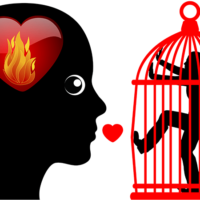Imagine drawing three circles on a paper entitled “My Relationship” or “My Previous Relationships.” The three circles represent how much of the relationship consists of “me” (my needs, wants, desires, moods, demands, etc.) “you” (your moods, wishes, dreams, demands, needs, etc.) and “us” (what serves our relationship, our commitment, our future, our connection.)
How much of your relationship is about “us?” How much is about “me?” And how much is about “you?” Where do the three intersect? Which one is the biggest circle: you, me or us? Which is the smallest circle?
Charlotte Kasl, the author of the book If The Buddha Married (Penguin Compass) says that in nearly every troubled relationship, there is a very small “us.” “Us” is about two people coming together to create and experience union, and where we both become allies to each other’s wounds, sensitivities, needs, dreams and pleasures.
She says that when we become part of something larger than ourselves, we can be released from the need to constantly worry about our own needs. “Because you value and appreciate your union, you automatically think about the impact of your behavior on your partner. Your desire to do what you want is tempered by thinking about how it will affect your relationship,” says Kasl.
So what can you do if you want to strengthen and enlarge the “us” part of your relationship? Kasl has several suggestions.
First, repeatedly ask the question to yourself and/or to the other “Am I creating closeness or separation?” Start noticing the difference between feeling close or distant. How does it feel in your body? In your heart? Do you know when you are afraid? When you’re withdrawing or retracting? Our voice, our stances, our words, our behavior, our attitudes either create a flow in the relationship or they create stress and tension. Nothing remains static.
Second, listen beneath the surface of the behavior and look for the positive intention. Underlying our behavior is almost always a positive intention. When we get angry, our positive intention may be to correct an injustice or to right a wrong. When we work too much and are all used up when we get home, our positive intention may be to earn enough money to support our lifestyle. If we listen for the positive intention in our partner, we can help ease a difficult situation by asking “What would you like from me?” “How can I be helpful?” “Is this what you were trying to communicate?” When we learn to reach out to the confusion and the pain of each other, we meet each other in the “us” place—and move toward the heart of understanding—rather than toward anger, reaction or distance. You can protect the “us” place by being attuned to partner—where you’re holding him/her in your heart at all times.
Finally, stay present in your interactions with your partner, and keep all the agreements you make. Do you notice about yourself that in such interactions that you’re distracted? Argumentative? Angry? If so, why? Address what’s going on at a subterranean level with your partner so you can be more fully present in the now.
A supportive “us” place is a form of alchemy, says Kasl. The seed and the water become the plant. We become the shared body, the shared heart, the shared connection, the shared vision.






